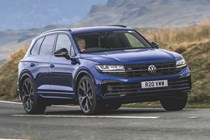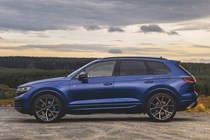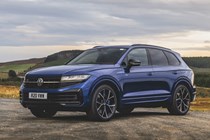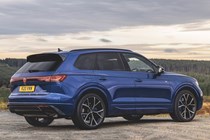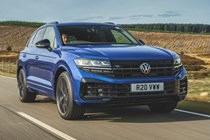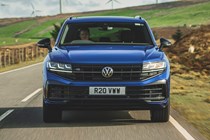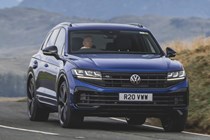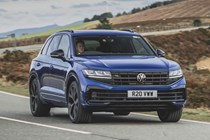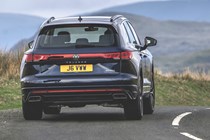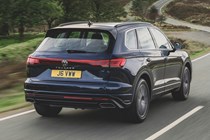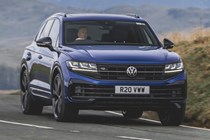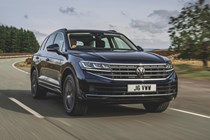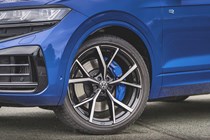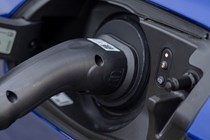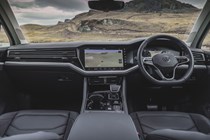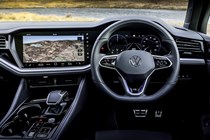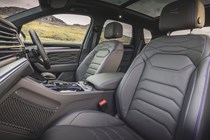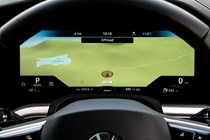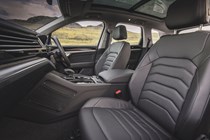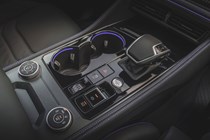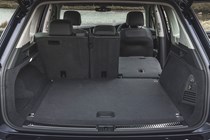
Volkswagen Touareg engines, drive and performance
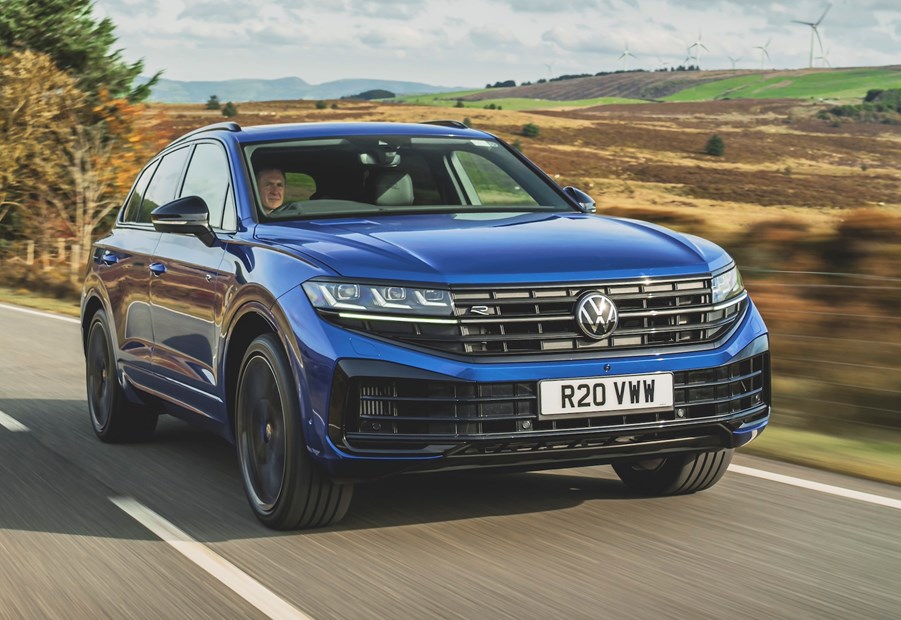
- 3.0-litre V6 petrols and a diesel
- Two plug-in hybrids – standard and R
- Relaxed, rather than exciting, delivery
Diesel engines
When it comes to the engine range Touareg buyers have a few choices, all based around Volkswagen Group’s excellent and highly-rated 3.0-litre V6. There are two diesel versions, a punchier petrol and two plug-in hybrids.
Starting with the diesels, the 3.0-litre TDI diesel V6 under the bonnet of the Touareg has a wide range of abilities. The entry-level 231hp diesel develops 500Nm of torque for a 0-62mph time of 7.5 seconds and a 135mph top speed. It’s a refined power unit, that’s quiet at a cruise if not as smooth as the straight-sixes from Land Rover and Mercedes. On the road, its relaxed demeanour makes light work of the steepest incline or heaviest load.
As you’d expect, it has ample pulling power from low revs, which is useful as when it’s driven in Eco mode, the transmission changes up into the highest possible gear at the earliest opportunity. Motorway cruising is effortless, although it never feels fast, it does build speed and momentum impressively.
The higher-powered 286hp diesel shares the 231hp version’s excellent refinement, but adds more urgency. It delivers bags of performance with a 0-62mph time of 6.1 seconds and a maximum speed of 146mph. That’s an impressive set of numbers, if not as quick as some of the punchier diesels out there. This is probably all of the Touareg that most people are going to need unless BIK tax is a major issue.
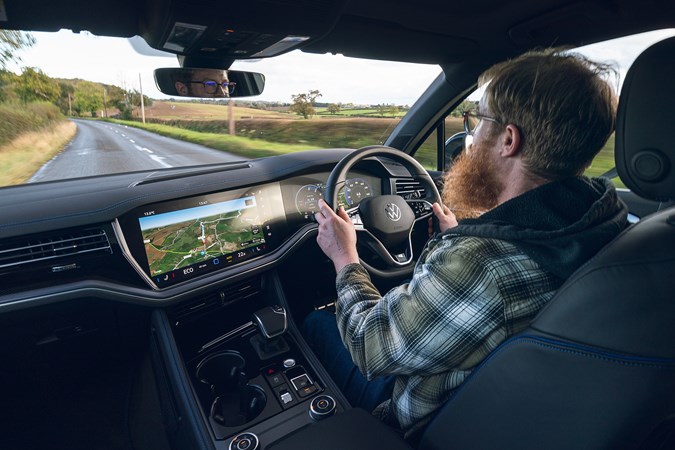
Petrol engine
The powerful 3.0-litre V6 TSI petrol unit brings more pace to the Touareg range – 0-62mph takes 5.9 seconds, making this the fastest car in the non-hybrid line-up. That said, 450Nm of torque (pulling power) means you have to work a little harder when the Touareg is up and moving, as it lacks the diesel’s in-gear punch.
Still, if you don’t do the miles to justify diesel costs then the petrol Touareg is, in many ways, the most satisfying. Our experience is that it’s much quieter at tickover and feels super smooth in its power delivery, with a more evocative engine note when you really stretch it.
There’s an additional penalty in terms of running costs as you’d imagine, and having to work the engine and gearbox harder than you would in either diesel means it’s easy to see those mpg figures tumble. And as such, the advantages of petrol in this installation are easily outweighed by the disadvantages – meaning it’s a much more difficult car to justify.
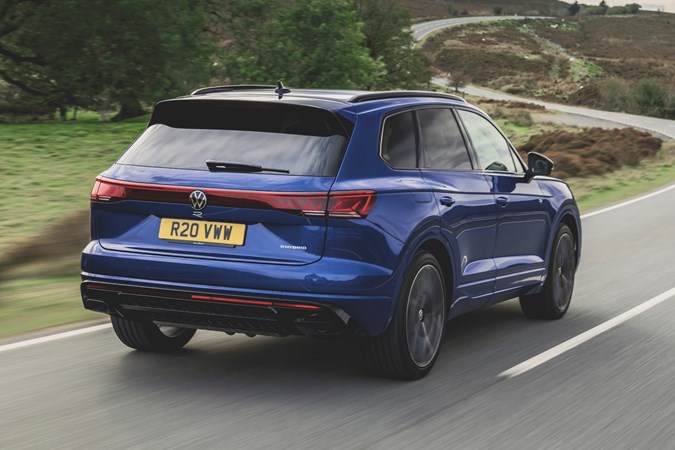
Hybrid engines
The plug-in hybrids should be the best of both worlds, combining petrol smoothness and potential diesel-style economy. The both use the petrol V6 in tandem with a chunky battery pack and electric motor. The entry-level eHybrid gets 381hp for a 0-62mph time of 5.9 seconds, only slightly quicker than the regular petrol. Transitions between power sources are smooth, but most rivals are faster and more efficient.
The range-topping R is plug-in hybrid only, developing a healthier 462hp, which probably explains why we like it. This additional power drops the 0-62mph time down to 5.1 seconds while proving only slightly less efficient. But don’t fixate on these numbers, because what the Touareg R does really well is high-speed cruising and outside lane overtaking. It majors on effortless punch and feels like it’s powered by a much larger engine than a 3.0-litre V6.
It’s sporty sounding, too, with a gravelly edge to its engine note when pushing, but remains quiet and unfussed when driven gently. Although it’s badged as an R, and performance is good in isolation, a Porsche Cayenne S E-Hybrid, let alone a Turbo S E-Hybrid would leave it for dead, which is disappointing considering how closely related they are.
What’s it like to drive?
- This is a two-tonne car, and you won’t forget it
- Body roll is nicely contained
- It’s hard to place on narrow roads
Once familiar with the Touareg, you can play with the various drive modes – Eco, Comfort, Sport, Normal and Off-Road using a rotary dial on the centre console. Cars with air suspension get another dial to control that, too.
Optional rear-wheel steering points the back wheels in the opposite direction to the fronts at low speed to help manoeuvring and parking, and in the same direction at high speed to aid stability. This system really comes into its own in town, giving this full-size SUV a turning circle similar in size to a Golf, while on the motorway, it makes quick lane changes feel safer. It’s more linear in its reactions than Mercedes-Benz’s system, too.

On A- and B-roads, it feels like the large car it is, and you don’t get the sense of agility that you’d hope for (and do get in a Range Rover Sport or BMW X5). The steering is precise and well weighted, while the handling is surefootedly neutral, but there’s a heaviness and feeling of unwieldiness that you can never escape from – so, it always feels like you’re piloting a two-tonne-plus vehicle.
Air suspension does help, as do the changes made to it to make it more sporty, in the R model. Despite the massive 22-inch wheels fitted to the Touareg R, it easily has the best blend of ride and handling of the range. Some might say it never engages as well as a Cayenne with a few choice options, but then it’s not designed to be as focused on handling as its kissing cousin.
Speaking of comfort, we’d avoid the steel springs that are standard on Elegance as they feel particularly brittle over urban roads, and lack the smoothness of the air-sprung cars. Refinement and low levels of mechanical noise are what dominate your first impressions, and that colours your overall perception of the comfort of the car. With not much wind or road noise, the Touareg is in its element on the motorway. You do hear and feel the engine at idle and they can sound a bit strained when pushed, though.


